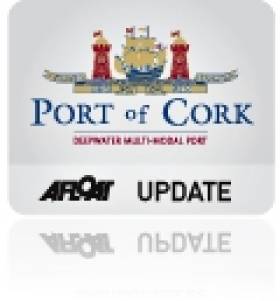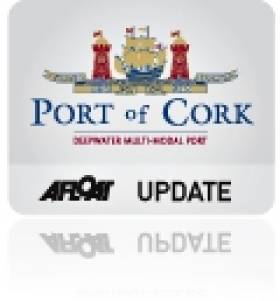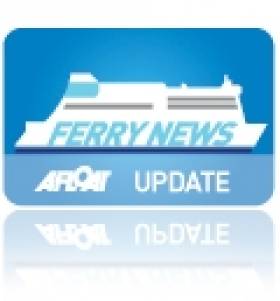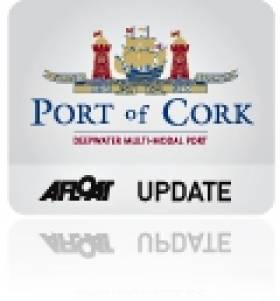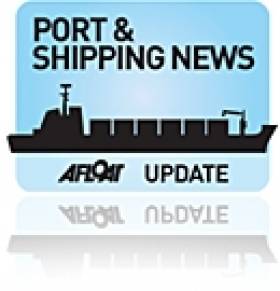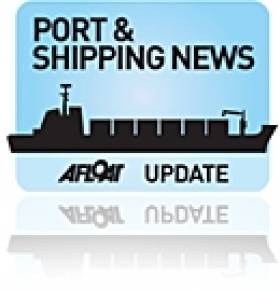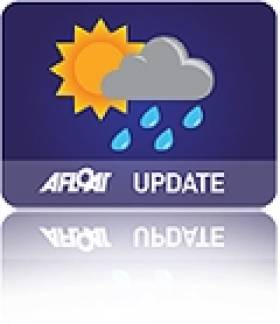Displaying items by tag: port of Cork
Clarion Hotel Promotion for Port of Cork Marina Visitors
Captain Pat Farnan, Port of Cork Harbour Master said: "The Port of Cork opened this new marina in 2010 and experienced a busy summer of visitors. We are aiming to attract more local and visiting boats to the marina this summer and we feel the joint promotion with the Clarion Hotel will be very effective."
He continued: "We hope to do further promotions around the marina throughout the summer."
The Port of Cork City Marina is ideally located in the heart of Cork City offering 150 metres of berthage with 24hr security, water, and electricity and refuse facilities. The Clarion Hotel is within 100m of the Port of Cork City Marina, making it ideally located for marina users who want to use the shower facilities.
The Port of Cork City Marina is a long term investment for the City of Cork which the Port of Cork implemented as part of their Leisure and Recreation Strategy for Cork Harbour. The primary focus of the strategy is on water based Leisure and Recreation activities in and around Cork Harbour in which the Port of Cork aims to play a leading role in providing and supporting improvements of amenities in these areas.
Cork Harbour offers significant potential for further development of the marine recreation sector as an important source of enjoyment and economic gain for the local residents and visitors. The Port of Cork, primarily providing commercial services to its customers, is conscious of its responsibility to all other stakeholders in Cork Harbour.
In Cork, the world's second largest natural harbour, it is critically important for both commercial and leisure to work together in harmony. The Port of Cork is committed to achieving this while also respecting the principles of environmental sustainability and corporate social responsibility.
Operating guidelines and charges for the Port of Cork City Marina are HERE
Amendments to Pilotage Byelaws
For further information about this and to download a copy of the Pilotage Byelaws click this link. In addition the port company has a draft copy of the Pilotage Byelaws which is available for collection from:
The Port of Cork Company, Custom House, Custom House Street, Cork
The port can be contacted by Tel: 021 4273125 and for other genaral information on the port logon to www.portofcork.ie
‘Proposed’ Cork-Spain Route Remains Under Review
In addition to services running out of Rosslare operated by Celtic Link Ferries and Irish Ferries and the alternative option of landbridge connections to Europe via the UK.
In the meantime, the Port of Cork will continue to be in dialogue with potential operators and investor's, however in the current climate it is proving more challenging to establish the service. Yet both the port authorities in Cork and Gijon remain committed in establishing the first direct Irish-Iberia passenger ferry route, with an update on the Spanish service due in early June.
Since 2008 the port authorities of Cork and Gijón, through the Promotion of Short Sea Shipping and Co-Operation with Small Medium Enterprise's (Proppose) an EU Inter-Reg project, have conducted feasibility studies into the service.
Interest in the service to date, has shown interest from Brittany Ferries, P&O Ferries and Transfennica, a Scandinavian based operator. It was envisaged that a ro-pax type of vessel would operate the 24-hour route to Gijón in Asturias, the region which forms part of Spain's northern 'Green' coast.
The route across the Bay of Biscay would be an attraction to freight hauliers, saving mileage and reduced fuel costs in addition avoiding a weekend ban to trucks travelling through France.
Last summer the ro-pax Norman Bridge started a new route between Nantes / St. Nazaire (Montoir-de-Bretagne) and Gijón, operated by GLD Atlantique. This route received support through the EU 'Motorways of the Seas' (MOS) programme to divert vehicle traffic from congested road-infrastructure and transferred to designated shipping routes, using larger and faster ro-pax vessels.
The route's opening was marked with a declaration signed by Dominique Bussereau, the French Minister of State responsible for Transport and his Spanish counterpart Magdalena Alvarez of the first of two Franco-Spanish MOS concept routes, starting with the 14-hour GLD Atlantique service.
- Irish Ferries
- port of Cork
- Celtic Link Ferries
- Fastnet Line
- P&O Ferries
- Brittany Ferries
- Ports and Shipping News
- Cork Harbour News
- RoPax
- Port of Gijón
- Proppose
- Motorways of the Seas
- MOS
- Transfennica
- CorkGijón
- Asturias
- 'Green'Spain
- Landbridge
- NantesSt.Nazaire
- GLD Atlantique
- Norman Bridge
- Cork Harbour
Port of Cork Traffic Up 10% in 2010
While all sectors at the Port of Cork experienced a challenging period during 2010, the end of year total trade traffic shows an increase. Total trade in 2010 through the Port of Cork amounted to 8.8 million tonnes, an increase of 8.6% compared to 2009.
One area of increase which has a very positive effect on the local economy is the increase in exports from the Port. Total exports at the Port of Cork have remained strong increasing by 10% to date, in comparison to 2009. Exports are a key driver in the successful recovery of the Irish Economy and the Port of Cork is committed to continuous support in the growth of international trade for both current and future economic prospects.
The container business at the Port of Cork has remained constant with over 150,000 TEU handled in 2010. Animal feed stuffs, fertiliser and other trades have shown a significant increase in 2010. Oil traffic has shown a slight increase of 3.5% as a consequence of lower levels of economic activity; however it continues to be a significant part of the Port of Cork business.
Commenting on the end of year trade traffic results, Mr Dermot O'Mahoney Chairman of the Port of Cork said: "The Port of Cork is pleased to announce that total trade traffic in 2010 has shown an 8.6 % increase on 2009 traffic. With 98% of all goods imported or exported from Ireland moved by ship, the importance of ports to our economy is vital. The Port of Cork is a key link to the continued economic success of the entire Munster region and the challenges now for the Port of Cork, is to continue to develop. This requires that we be visionary and seize opportunities presented by emerging trends and logistic supply changes."
He continued: "While the next four to five years will be challenging for us all, we need to continue to promote the fact that Ireland is an excellent investment location and is well placed to capitalise on growing global markets."
52 cruise liners visited the Port of Cork during 2010 bringing over 100,000 passengers and crew to the region. According to research carried out by UK consultants GP Wild, the average in-transit spend per passenger, while visiting an Irish port is €73. This is a significant contribution towards the local tourism economy.
Ferry passenger numbers though the port also increased mainly due to the welcomed re-commencement of the ferry service linking Cork with Swansea. The weekly ferry service from Cork to Roscoff with Brittany Ferries also had a successful year.
In 2010, the Port of Cork developed a recreational strategy to improve the marine leisure facilities around Cork Harbour. The first project carried out was the construction of a 100m marina on South Custom House Quay. This long term investment for the city of Cork has already proven to be very popular among local boats and visiting boats. The Port of Cork expects 2011 to be even busier.
Fastnet Line Cancel Tonight's Sailing
Operators of the Cork-Swansea route, Fastnet Line regret to announce that tonight's (13 January) sailing from Cork to Swansea is cancelled. The company has cited technical reasons for the cancellation of the sailing. The 10-hour route linking Munster with South Wales is served by the M.V. Julia.
Fastnet Line are contacting all passengers to assist in making re-bookings or refunds. Those wishing to contact the ferry operators' reservation team for further information can contact the details listed below.
The Julia is to go into dry-dock this week in Swansea. The vessel will remain in Swansea while undergoing annual maintenance up to and including Wednesday 9th February. Her first sailing will be at 20.30hrs from Swansea to Cork on Wednesday 9th February 2011.
To contact the Fastnet Line Irish Reservations Office Tel: +353 (0) 21 4378892 (Open Monday – Friday) 9.00 am - 6.00 pm
To contact the UK Reservations Office Tel: 0844 576 8831
(Open Monday – Thursday) 8.00 am - 8.00 pm
(Open Friday) 8.00 am - 7.00 pm
(Open Saturday and Sunday) 9.00 am - 6.00pm
For further information logon to www.fastnetline.com
Salt Shipments Bound for Cork
In total the National Roads Authority (NRA) will have 25,000 tonnes of salt available during the Christmas week, with 3,000 tonnes distributed to authorities on a daily basis. As a priority the salt will be used to grit the national primary network.
The second bout of artic conditions that has gripped the country with temperatures plummeting to -17 degrees in the west and -15 degrees is forecast tonight in the north-west. Further snowfalls are also due in various regions tonight and with sub-zero temperatures expected to last up to St. Stephens Day. As such the demand for salt supplies has soared resulting in shipments sourced from overseas countries to include Turkey and Egypt.
CFL Prospect (see video-clip here) is owned by the Dutch shipping company, Kees Koolhof which since 2006 has built up a fleet of modern vessels to trade in the short-sea sector. The 2007 built vessel is one of nine Jumbo 6500s from a series completed by the Peters Shipyard at Krampen.
For the latest NRA's road weather stations logon here in addition to weather forecasts from www.met.ie
Emergency Salt Shipments Supplies Due To Arrive
Two vessels, the CSL Prospect and Olivia are heading for the Port of Cork with a combined cargo of 11,500 tonnes of salt. In the meantime councils are coping with rapidly dwindling supplies to keep the main roads gritted over the weekend. If the councils fail to ration supplies, the authorities will quickly run out of salt, sparking a crisis for motorists. For more on this story click here.
The Port of Cork added that these salt-shipments will continue beyond next week. In addition to next weeks delivery, more vessels will be calling to the port, bringing in total 35,000 tonnes of salt over the next few weeks.
According to weather forecasts, there will be significant accumulations of snow expected in most parts of the country. Up to 10cm of snow may fall over the next few days. For information on the latest weather updates logon to www.met.ie/forecasts/
Port of Cork Calling all 5th Class Teachers!
School-children will be able to earn about the harbour and how it could be used to harness energy such as wind, wave, gas, electricity and other forms of energy. In addition it will provide an opportunity for the participants to be creative and futuristic about Cork harbour. Children can also look at the importance of green energy in their home and school.
The projects are to be presented in artwork format using paintings, models or photographs. Submitted projects will go on public display in the Cork Customs House for six weeks before the winner is announced in April 2011.
All 5th classes who take part in the Port of Cork Schools Initiative are treated to a boat trip around Cork harbour and each class will receive a certificate of participation. Prizes will be given for the best artwork piece and best photograph.
The overall winner of the Schools Initiative project will receive a tour onboard one of the many cruise liners that are to visit Cork Harbour next summer.
Closing date for entries is 18th March 2011. For further information on this year's schools project and how to get involved you can contact Captain Pat Murphy Tel: 021 4625312 or by Email [email protected] and by logging on to www.portofcork.ie
In addition you can view below a video depicting liners of yesteryear and the cruiseships that visit Cork Harbour, the world's second largest natural harbour.
CMA–CGM Win Port of Cork Sponsored Deep Sea Shipping Award
The Port of Cork was delighted to sponsor the Irish Exporter Awards category, 'Deep Sea Shipping Company'. The award was presented to CMA-CGM Shipping Ireland Ltd for providing global container shipping solutions for companies in all sectors, at an awards ceremony in Dublin's RDS on Thursday 25th November, attended by Minister Batt O'Keefe.
Captain Michael McCarthy, Commercial Manager Port of Cork said: As Ireland's primary deep water port, the Port of Cork has a long term focus on meeting the needs of deep sea shipping lines and understands the importance of growing the export market.'
He continued: 'This is the second year sponsoring such an award and we were delighted to sponsor the Deep Sea Shipping Company Award for 2010. We look forward to supporting the growth of international trade for both current and future economic prospects.'
Other nominees of this category were Dublin based companies: APL Ltd., CMA-CGM Shipping Ireland Ltd. and Maersk Line.
IEA Export Industry Awards to Shipping
In the category of Short Sea Shipping Company of the Year, sponsored by the Irish Maritime Development Office, which recognises the strategically important role of short sea shipping to our economy, the winner of the award was CLDN Colbefret Group.
The Belgium operator opened two new routes from Dublin to Rotterdam and Zeebrugge in November last year, providing a range of transport options to Irish exporters selling to Europe. Since then Cobelfret have gradually introduced new Con-Ro (Containers and Roll-On/Roll-Off) vessels onto the continental routes. The six 25,000 gross tonnes newbuilds were built by FGS Flensburg, Germany and the latest unit Opaline, is due to make a Dublin debut tomorrow.
Cobelfret's operations in Dublin are based in Alexandra Basin East using the ports No. 2 ro-ro linkspan berth. A previous linkspan built in the 1950's was demolished last summer to develop a larger linkspan, to cater for larger tonnage like the Opaline. The new vessel has 2,907 lane metres for freight vehicles spread over three decks and a container capacity for 854 TEU mafi-trailers.
Donegal based Marine Harvest won the Seafood Export Award, sponsored by Bord Biá. The company is an indigenous fully-integrated salmon breeding, farming and processing operation, exporting premium products to Europe and North America.
The overall winner of the IEA's Export Industry Award for 2010 was the Irish Dairy Board.



























